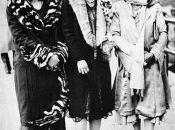The Hatfield-McCoy feud is one of the most infamous family conflicts in American history, primarily occurring in the late 19th century along the West Virginia–Kentucky border. The feud originated from a variety of factors including land disputes, political differences, and personal vendettas between the Hatfield and McCoy families.
The feud reached its peak in the 1880s and early 1890s, marked by a series of violent encounters and retaliations between the two clans. One of the most well-known incidents was the 1882 New Year’s Night massacre, where three McCoy brothers were killed by members of the Hatfield family. This event escalated tensions and fueled further violence.
The feud garnered widespread attention across the United States, captivating the public imagination with tales of family vendettas, revenge killings, and vigilante justice. It became a symbol of the lawlessness and violence that characterized the Appalachian region during that era.
Ultimately, the feud began to subside with the intervention of law enforcement and legal authorities. Several members of both families were arrested and tried for various crimes, bringing an end to the most intense period of conflict. However, the legacy of the Hatfield-McCoy feud continues to endure in American folklore and popular culture, immortalizing it as one of the most infamous family conflicts in history.

The wall depicts Hatfield-McCoy feud
It’s a good idea to look at these 14 interesting facts about Hatfield and McCoy to know more about this conflict.
- Origins of the Feud: The Hatfield-McCoy feud is believed to have begun in the years following the American Civil War, intensifying during the 1880s and early 1890s. It stemmed from a combination of factors including land disputes, Civil War loyalties, and personal grievances.
- Geographic Boundary: The feud primarily took place along the Tug Fork of the Big Sandy River in the Appalachian Mountains, straddling the border between West Virginia and Kentucky. This rugged and isolated terrain played a significant role in the intensity and longevity of the conflict.
- Devil Anse Hatfield and Randolph McCoy: The two central figures in the feud were Devil Anse Hatfield and Randolph McCoy, patriarchs of their respective families. Their rivalry and animosity towards each other fueled much of the violence and bloodshed.
- Religious Differences: Religious differences exacerbated tensions between the two families. The Hatfields were primarily associated with the Primitive Baptist Church, while the McCoys were affiliated with the Church of Christ. These religious disparities contributed to the divide between the clans.
- Economic Disparities: The Hatfields were often portrayed as wealthier and more prosperous compared to the McCoys, which further fueled resentment and jealousy among the poorer McCoy clan members.
- Feud Erupts: The feud escalated with the murder of Asa Harmon McCoy, a Union soldier, in 1865. While the Hatfields were suspected of involvement, no one was ever prosecuted for the crime, leading to deep-seated animosity between the families.
- New Year’s Night Massacre: One of the most notorious incidents of the feud occurred on New Year’s Night of 1882 when three McCoy brothers were killed by a group of Hatfield vigilantes. This event marked a turning point, escalating the conflict to new levels of violence.
- Bounty Hunters: At various points during the feud, both families employed bounty hunters and mercenaries to track down and eliminate their enemies. This led to a cycle of revenge killings and counterattacks.
- Legal Intervention: The feud attracted national attention and eventually led to legal intervention. In 1888, a series of trials began, resulting in several Hatfields being convicted and sentenced to long prison terms for their involvement in the killings.
- Governor’s Pardon: In a controversial move, Kentucky Governor William O’Connell Bradley granted a pardon to several Hatfield family members in 1896, effectively ending the legal repercussions of the feud.
- Aftermath: Despite the official end of hostilities, tensions between the families persisted for years. However, subsequent generations of Hatfields and McCoys have worked towards reconciliation, with some even marrying into each other’s families.
- Tourist Attractions: Today, the Hatfield-McCoy feud remains a popular tourist attraction in Appalachia. Visitors can explore sites related to the feud, such as the Hatfield-McCoy Feud Sites Historic District and the McCoy Homeplace.
- Television and Film Adaptations: The feud has been depicted in numerous films, television shows, and books, cementing its place in popular culture. One of the most notable adaptations is the History Channel miniseries “Hatfields & McCoys,” starring Kevin Costner and Bill Paxton.
- Historical Legacy: The Hatfield-McCoy feud is not only a fascinating tale of family rivalry and violence but also serves as a cautionary reminder of the consequences of unchecked vendettas and the importance of conflict resolution. It remains an enduring symbol of Appalachian folklore and American history.
In the annals of American history, the Hatfield-McCoy feud stands as a testament to the enduring power of family loyalties, the complexities of human relationships, and the consequences of unchecked vendettas. What began as a localized dispute over land and honor escalated into a decades-long saga of violence and tragedy, leaving an indelible mark on the landscape of Appalachia and the national consciousness. Yet, amidst the bloodshed and animosity, there also emerged tales of resilience, reconciliation, and the capacity for forgiveness. Today, the legacy of the Hatfield-McCoy feud serves as a reminder of the importance of dialogue, understanding, and the pursuit of peace, reflecting both the darkest and most hopeful aspects of the human experience.





